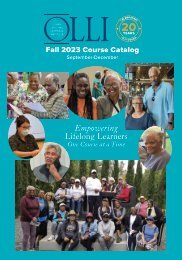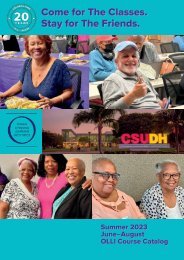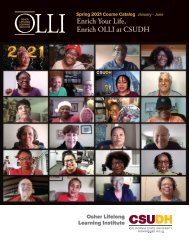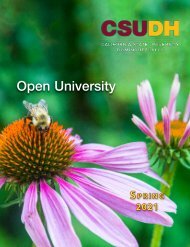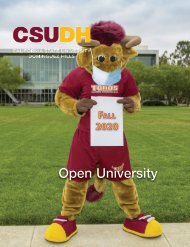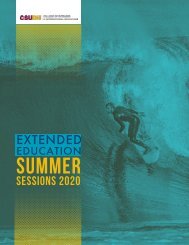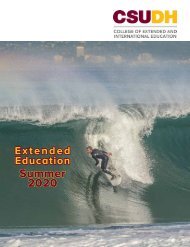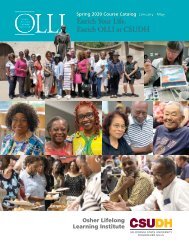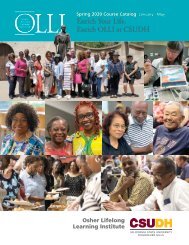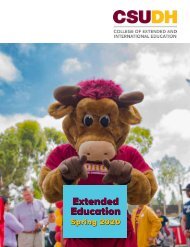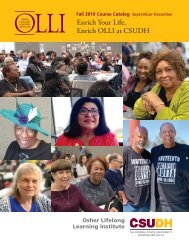Spring 2017 OLLI Catalog (Interactive)
The Osher Lifelong Learning at California State University Dominguez Hills is a program of educational, cultural, and social opportunities for retired and semi-retired individuals age 50 and above. Members experience taking courses in a relaxed atmosphere for the pure pleasure of learning.
The Osher Lifelong Learning at California State University Dominguez Hills is a program of educational, cultural, and social opportunities for retired and semi-retired individuals age 50 and above. Members experience taking courses in a relaxed atmosphere for the pure pleasure of learning.
You also want an ePaper? Increase the reach of your titles
YUMPU automatically turns print PDFs into web optimized ePapers that Google loves.
PEER-LED CLASSES (Omnilore)<br />
Common Reading:<br />
The History of the<br />
Mongol Conquests,<br />
by J. J. Saunders (March 2001)<br />
(MON) The Mongols<br />
The Mongols established the most extensive land empire in the<br />
history of the world. The Mongol conquests, culminating in the<br />
invasion of Europe in the middle of the 13th Century, were of a<br />
scope and range never equaled. These nomadic peoples from<br />
central Asia briefly held sway over a territory that stretched from<br />
the Pacific Ocean to Germany, from the rivers of the Baltic to the<br />
shores of the Adriatic. No European army was their equal;<br />
no European country was able to resist their assaults. Who were<br />
these people? What drove them on their quest? Why were they<br />
so invincible? How were they finally stopped? Our goal will be<br />
to learn of the Mongols and their place in history, and how they<br />
nearly changed the face of the civilization.<br />
Common Reading:<br />
Arrival of the Fittest:<br />
Solving Evolution’s Greatest Puzzle<br />
by Andreas Wagner (October 2014)<br />
(NAT) Arrival of the Fittest:<br />
How Nature Innovates<br />
This class will explore the continuing developments in Evolutionary<br />
theory. The question “how does nature innovate?” often elicits a<br />
succinct but unsatisfying response—random mutations. Darwin’s<br />
theory of natural selection explains how useful adaptations are<br />
preserved over time. But the biggest mystery about evolution<br />
eluded him. As genetics pioneer Hugo de Vries put it, “natural<br />
selection may explain the survival of the fittest, but it cannot<br />
explain the arrival of the fittest.”<br />
In Arrival of the Fittest, renowned evolutionary biologist Andreas<br />
Wagner draws on over fifteen years of research to present the<br />
missing piece in Darwin’s theory. Using experimental and<br />
computational technologies that were heretofore unimagined,<br />
he has found that adaptations are not just driven by chance,<br />
but by a set of laws that allow nature to discover new molecules<br />
and mechanisms in a fraction of the time that random variation<br />
would take. He shows how nature innovates but also how these<br />
two complementary forces of nature—innovation and natural<br />
selection interact and balance to create, sustain, and evolve life<br />
with all its rich complexity.<br />
42 OSHER LIFELONG LEARNING INSTITUTE @ CSU DOMINGUEZ HILLS




